#Which is not enjoyable
Text
Sorry for the Homestuck 2 hot take, but I really like James Roach’s new direction for the project. You can really feel the joy behind it, makes it feel fun again.
#homestuck#homestuck 2#The Epilogues and Homestuck 2 (with a bit of Homestuck proper) felt like it had a lot of anger behind them#I love the notion of characters rejecting the narrative#But with Homestuck it just felt like the author(s) punishing the fans for being fans#Which is not enjoyable#To make or read#It’s really easy to internalize the crazy and the negative#Of how people react and engage with your work#That it affects you deeply and negatively#I’m glad James Roach hasn’t let any of the Homestuck 2 negativity get to him as he takes over the project#And really shares just why he likes Homestuck#delete later //
68 notes
·
View notes
Video
highest-grossing multimedia juggernaut of all time
#video#to answer the obligatory questions:#footage was recorded on an actual switch (with a dump of a retail cartridge installed to it)#the only editing was the yungoos which was sped up for comedic effect#day 1 patch is installed as noted in the video#yes the game is still decently enjoyable#no it absolutely isn't worth $60
8K notes
·
View notes
Text

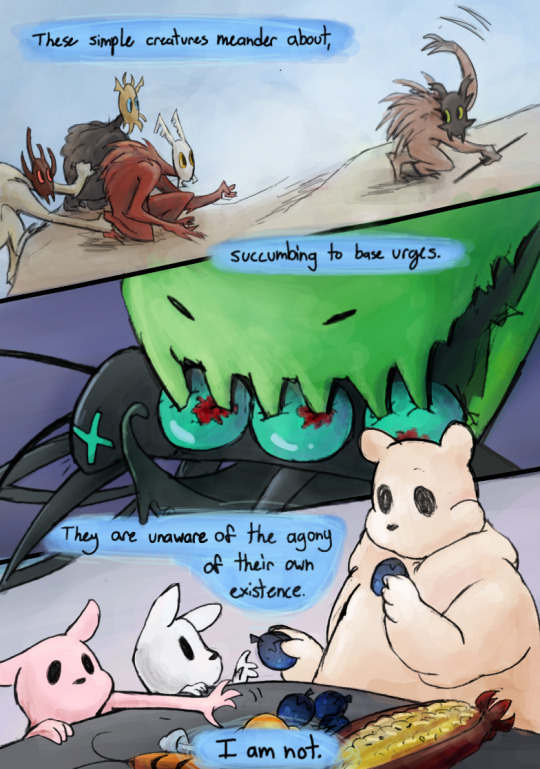

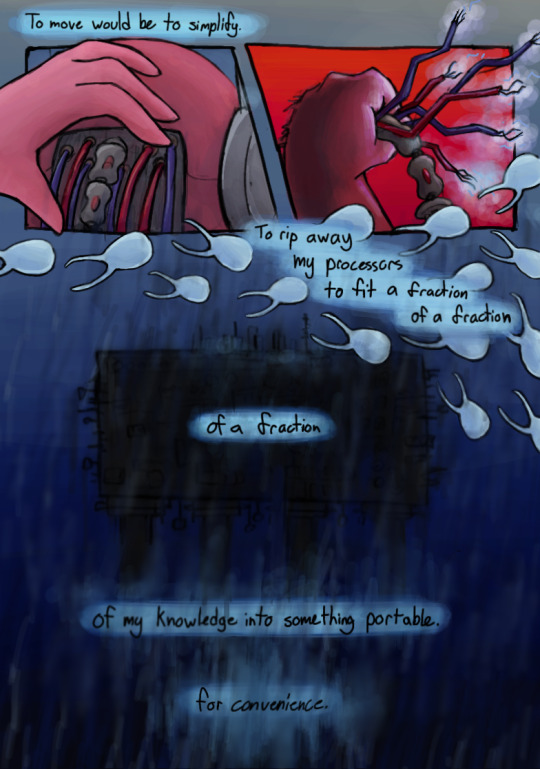

case study of the self-identified god
#obsessed with the fact that rain world is a game about survival#yet every character we meet has the express goal of trying to optimize killing themselves#every creature in game seems perfectly content fulfilling their role in the ecosystem no matter how many cycles they do the same thing#(rly obvious with gourmand's entire route. guy who lives their life to the fullest without the slightest hint of resentment)#it was really only the ancients who thought they were above it and thought of it as something to escape from#5pebbles is so interesting because the only reason hes “”“godlike”“” is because of his vast knowledge. if he was in any slugcats shoes he#would die instantly which is ironically what hes been trying to do this whole time#this comic was kind of exploring the idea of awareness (divinity) as something that drags down ones enjoyment of life (walking).#if 5p would humble himself down enough to walk around like any other creature#he would a) be much happier in life and b) achieve the ascension he's been gunning for for millennia like all the slugcats did#but he never will.#getting rid of all his work on the problem or even his awareness of it entirely#would just be a trick of convenience that steals away his godhood#and him calling himself godlike is kind of a cope LOL#a cope being faced with a problem he was never meant to solve#a cope being faced with what he did to moon#a cope being faced with the rot inside him#oh well.#anyway fuck 5 pebbles i hate that guy#rain world#rain world fanart#rw five pebbles#rain world five pebbles#rw gourmand#rain world gourmand#five pebbles#rain world void worm#rain world ancients#also JUST KIDDING ilu 5p. you suck but i💛u
2K notes
·
View notes
Text
Very interesting to me that a certain subset of the BES fandom's favourite iterations of Mizu and Akemi are seemingly rooted in the facades they have projected towards the world, and are not accurate representations of their true selves.
And I see this is especially the case with Mizu, where fanon likes to paint her as this dominant, hyper-masculine, smirking Cool GuyTM who's going to give you her strap. And this idea of Mizu is often based on the image of her wearing her glasses, and optionally, with her cloak and big, wide-brimmed kasa.
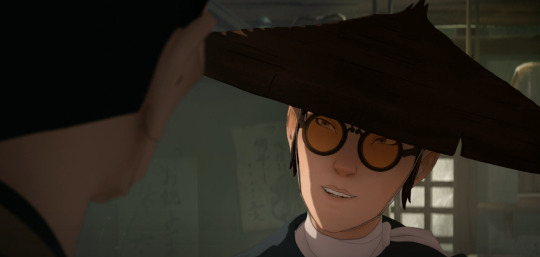

And what's interesting about this, to me, is that fanon is seemingly falling for her deliberate disguise. Because the glasses (with the optional combination of cloak and hat) represent Mizu's suppression of her true self. She is playing a role.

Take this scene of Mizu in the brothel in Episode 4 for example. Here, not only is Mizu wearing her glasses to symbolise the mask she is wearing, but she is purposely acting like some suave and cocky gentleman, intimidating, calm, in control. Her voice is even deeper than usual, like what we hear in her first scene while facing off with Hachiman the Flesh-Trader in Episode 1.
This act that Mizu puts on is an embodiment of masculine showboating, which is highly effective against weak and insecure men like Hachi, but also against women like those who tried to seduce her at the Shindo House.


And that brings me to how Mizu's mask is actually a direct parallel to Akemi's mask in this very same scene.
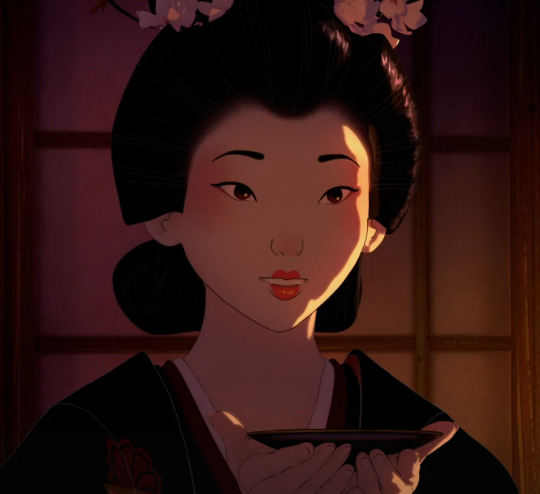
Here, Akemi is also putting up an act, playing up her naivety and demure girlishness, using her high-pitched lilted voice, complimenting Mizu and trying to make small talk, all so she can seduce and lure Mizu in to drink the drugged cup of sake.
So what I find so interesting and funny about this scene, characters within it, and the subsequent fandom interpretations of both, is that everyone seems to literally be falling for the mask that Mizu and Akemi are putting up to conceal their identities, guard themselves from the world, and get what they want.
It's also a little frustrating because the fanon seems to twist what actually makes Mizu and Akemi's dynamic so interesting by flattening it completely. Because both here and throughout the story, Mizu and Akemi's entire relationship and treatment of each other is solely built off of masks, assumptions, and misconceptions.
Akemi believes Mizu is a selfish, cocky male samurai who destroyed her ex-fiance's career and life, and who abandoned her to let her get dragged away by her father's guards and forcibly married off to a man she didn't know. on the other hand, Mizu believes Akemi is bratty, naive princess who constantly needs saving and who can't make her own decisions.
These misconceptions are even evident in the framing of their first impressions of each other, both of which unfold in these slow-motion POV shots.
Mizu's first impression of Akemi is that of a beautiful, untouchable princess in a cage. Swirling string music in the background.
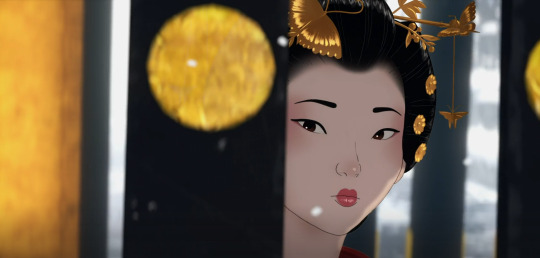
Akemi's first impression of Mizu is of a mysterious, stoic "demon" samurai who stole her fiance's scarf. Tense music and the sound of ocean waves in the background.

And then, going back to that scene of them together in Episode 4, both Mizu and Akemi continue to fool each other and hold these assumptions of each other, and they both feed into it, as both are purposely acting within the suppressive roles society binds them to in order to achieve their goals within the means they are allowed (Akemi playing the part of a subservient woman; Mizu playing the part of a dominant man).

But then, for once in both their lives, neither of their usual tactics work.
Akemi is trying to use flattery and seduction on Mizu, but Mizu sees right through it, knowing that Akemi is just trying to manipulate and harm her. Rather than give in to Akemi's tactics, Mizu plays with Akemi's emotions by alluding to Taigen's death, before pinning her down, and then when she starts crying, Mizu just rolls her eyes and tells her to shut up.

On the opposite end, when Mizu tries to use brute force and intimidation, Akemi also sees right through it, not falling for it, and instead says this:
"Under your mask, you're not the killer you pretend to be."

Nonetheless, despite the fact that they see a little bit through each other's masks, they both still hold their presumptions of each other until the very end of the season, with Akemi seeing Mizu as an obnoxious samurai swooping in to save the day, and Mizu seeing Akemi as a damsel in distress.
And what I find a bit irksome is that the fandom also resorts to flattening them to these tropes as well.
Because Mizu is not some cool, smooth-talking samurai with a big dick sword as Akemi (and the fandom) might believe. All of that is the facade she puts up and nothing more. In reality, Mizu is an angry, confused and lonely child, and a masterful artist, who is struggling against her own self-hatred. Master Eiji, her father figure who knows her best, knows this.

And Akemi, on the other hand, is not some girly, sweet, vain and spoiled princess as Mizu might believe. Instead she has never cared for frivolous things like fashion, love or looks, instead favouring poetry and strategy games instead, and has always only cared about her own independence. Seki, her father figure who knows her best, knows this.
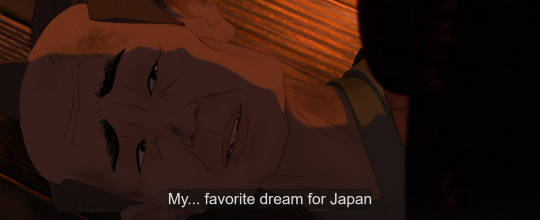

But neither is she some authoritative dominatrix, though this is part of her new persona that she is trying to project to get what she wants. Because while Akemi is willful, outspoken, intelligent and authoritative, she can still be naive! She is still often unsure and needs to have her hand held through things, as she is still learning and growing into her full potential. Her new parental/guardian figure, Madame Kaji, knows this as well.
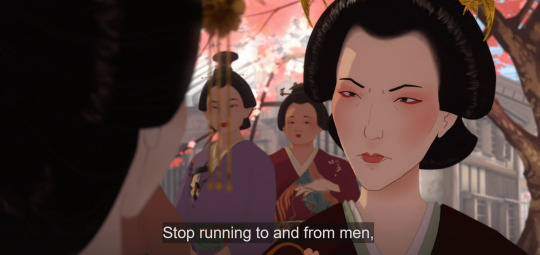
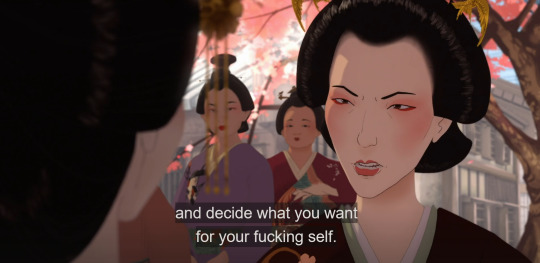
So with all that being said, now that we know that Mizu and Akemi are essentially wearing masks and putting up fronts throughout the show, what would a representation of Mizu's and Akemi's true selves actually look like? Easy. It's in their hair.
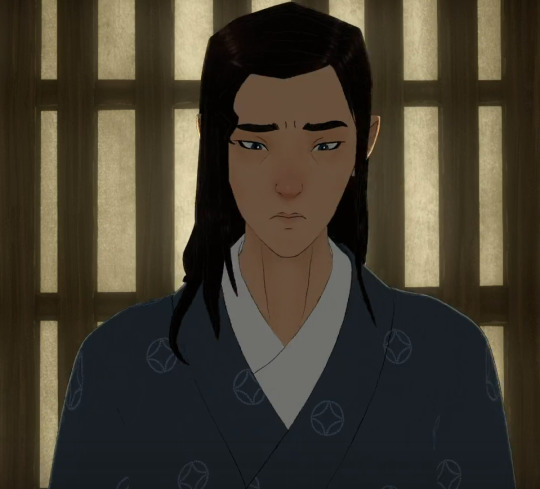

This shot on the left is the only time we see Mizu with her hair completely down. In this scene, she's being berated by Mama, and her guard is completely down, she has no weapon, and is no longer wearing any mask, as this is after she showed Mikio "all of herself" and tried to take off the mask of a subservient housewife. Thus, here, she is sad, vulnerable, and feeling small (emphasised further by the framing of the scene). This is a perfect encapsulation of what Mizu is on the inside, underneath all the layers of revenge-obsession and the walls she's put around herself.
In contrast, the only time we Akemi with her hair fully down, she is completely alone in the bath, and this scene takes place after being scorned by her father and left weeping at his feet. But despite all that, Akemi is headstrong, determined, taking the reigns of her life as she makes the choice to run away, but even that choice is reflective of her youthful naivety. She even gets scolded by Seki shortly after this in the next scene, because though she wants to be independent, she still hasn't completely learned to be. Not yet. Regardless, her decisiveness and moment of self-empowerment is emphasised by the framing of the scene, where her face takes up the majority of the shot, and she stares seriously into the middle distance.
To conclude, I wish popular fanon would stop mischaracterising these two, and flattening them into tropes and stereotypes (ie. masculine badass swordsman Mizu and feminine alluring queen but also girly swooning damsel Akemi), all of which just seems... reductive. It also irks me when Akemi is merely upheld as a love interest and romantic device for Mizu and nothing more, when she is literally Mizu's narrative foil (takes far more narrative precedence over romantic interest) and the deuteragonist of this show. She is her own person. That is literally the theme of her entire character and arc.
#blue eye samurai#mizu blue eye samurai#akemi blue eye samurai#blue eye samurai meta#just in case... im gonna tag this as#mizukemicritical#akemizucritical#though this post isnt actually criticising the ship itself but rather fanon's portrayal of the ship and the characters#for that reason lemme also tag this as#wank.mp3#feel free to disagree of course but please be civil#and if you need to rant about how wrong i am without any convincing evidence kindly feel free to make your own post. peace and love <3#fandom.rtf#meta dissertations.pdf#shut up haydar#edit: for full disclosure. i do rather dislike this ship. but obviously it's fine for anyone to enjoy it. please do! have your fun!#it's just that as usual! popular fanon and fandom around a ship is what has completely deterred me from any sense of enjoyment of it#it's a shame too because i was very open and even eager for some mizu/akemi romance in the future#but out-of-character fanon + the rudeness of certain fans has definitely soured it for me#but that doesn't mean people can't enjoy it obviously! ship and let ship!!!#plus it has its appeal which i DO STILL see and enjoy!!!!#i would even go as far as to call them soulmates because their narratives and characters are LITERALLY intertwined!!!#but. yeah. my gradual distaste for this ship is indeed very unfortunate.
723 notes
·
View notes
Text
None Of You Know What Haiku Are
I'm going to preface this by saying that i am not an expert in ANY form of poetry, just an enthusiast. Also, this post is... really long. Too long? Definitely too long. Whoops! I love poetry.
If you ask most English-speaking people (or haiku-bot) what a haiku is, they would probably say that it's a form of poetry that has 3 lines, with 5, and then 7, and then 5 syllables in them. That's certainly what I was taught in school when we did our scant poetry unit, but since... idk elementary school when I learned that, I've learned that that's actually a pretty inaccurate definition of haiku. And I think that inaccurate definition is a big part of why most people (myself included until relatively recently!) think that haiku are kind of... dumb? unimpressive? simple and boring? I mean, if you can just put any words with the right number of syllables into 3 lines, what makes it special?
Well, let me get into why the 5-7-5 understanding of haiku is wrong, and also what makes haiku so special (with examples)!
First of all, Japanese doesn't have syllables! There's a few different names for what phonetic units actually make up the language- In Japanese, they're called "On" (音), which translates to "sound", although English-language linguists often call it a "mora" (μ), which (quoting from Wikipedia here) "is a basic timing unit in the phonology of some spoken languages, equal to or shorter than a syllable." (x) "Oh" is one syllable, and also one mora, whereas "Oi" has one syllable, but two moras. "Ba" has one mora, "Baa" has two moras, etc. In English, we would say that a haiku is made up of three lines, with 5-7-5 syllables in them, 17 syllables total. In Japanese, that would be 17 sounds.
For an example of the difference, the word "haiku", in English, has 2 syllables (hai-ku), but in Japanese, はいく has 3 sounds (ha-i-ku). "Christmas" has 2 syllables, but in Japanese, "クリスマス" (ku-ri-su-ma-su) is 5 sounds! that's a while line on its own! Sometimes the syllables are the same as the sounds ("sushi" is two syllables, and すし is two sounds), but sometimes they're very different.
In addition, words in Japanese are frequently longer than their English equivalents. For example, the word "cuckoo" in Japanese is "ほととぎす" (hototogisu).
Now, I'm sure you're all very impressed at how I can use an English to Japanese dictionary (thank you, my mother is proud), but what does any of this matter? So two languages are different. How does that impact our understanding of haiku?
Well, if you think about the fact that Japanese words are frequently longer than English words, AND that Japanese counts sounds and not syllables, you can see how, "based purely on a 17-syllable counting method, a poet writing in English could easily slip in enough words for two haiku in Japanese” (quote from Grit, Grace, and Gold: Haiku Celebrating the Sports of Summer by Kit Pancoast Nagamura). If you're writing a poem using 17 English syllables, you are writing significantly more content than is in an authentic Japanese haiku.
(Also not all Japanese haiku are 17 sounds at all. It's really more of a guideline.)
Focusing on the 5-7-5 form leads to ignoring other strategies/common conventions of haiku, which personally, I think are more interesting! Two of the big ones are kigo, a season word, and kireji, a cutting word.
Kigo are words/phrases/images associated with a particular season, like snow for winter, or cherry blossoms for spring. In Japan, they actually publish reference books of kigo called saijiki, which is basically like a dictionary or almanac of kigo, describing the meaning, providing a list of related words, and some haiku that use that kigo. Using a a particular kigo both grounds the haiku in a particular time, but also alludes to other haiku that have used the same one.
Kireji is a thing that doesn't easily translate to English, but it's almost like a spoken piece of punctuation, separating the haiku into two parts/images that resonate with and add depth to each other. Some examples of kireji would be "ya", "keri", and "kana." Here's kireji in action in one of the most famous haiku:
古池や 蛙飛び込む 水の音
(Furu ike ya kawazu tobikomu mizu no oto)
(The old pond —
A frog jumps in
The sound of the water.)
You can see the kireji at the end of the first line- 古池や literally translates to "old pond ya". The "ya" doesn't have linguistic meaning, but it denotes the separation between the two focuses of the haiku. First, we are picturing a pond. It's old, mature. The water is still. And then there's a frog! It's spring and he's fresh and new to the world! He jumps into the pond and goes "splash"! Wowie! When I say "cutting word", instead of say, a knife cutting, I like to imagine a film cut. The camera shows the pond, and then it cuts to the frog who jumps in.
English doesn't really have a version of this, at least not one that's spoken, but in English language haiku, people will frequently use a dash or an ellipses to fill the same role.
Format aside, there are also some conventions of the actual content, too. They frequently focus on nature, and are generally use direct language without metaphor. They use concrete images without judgement or analysis, inviting the reader to step into their shoes and imagine how they'd feel in the situation. It's not about describing how you feel, so much as it's about describing what made you feel.
Now, let's put it all together, looking at a haiku written Yosa Buson around 1760 (translated by Harold G. Henderson)
The piercing chill I feel:
my dead wife's comb, in our bedroom,
under my heel
We've got our kigo with "the piercing chill." We read that, and we imagine it's probably winter. It's cold, and the kind of cold wind that cuts through you. There's our kireji- this translation uses a colon to differentiate our two images: the piercing chill, and the poet stepping on his dead wife's comb. There's no descriptions of what the poet is feeling, but you can imagine stepping into his shoes. You can imagine the pain he's experiencing in that moment on your own.
"But tumblr user corvidcall!" I hear you say, "All the examples you've used so far are Japanese haiku that have been translated! Are you implying that it's impossible for a good haiku to be written in English?" NO!!!!! I love English haiku! Here's a good example, which won first place in the 2000 Henderson haiku contest, sponsored by the Haiku Society of America:
meteor shower . . .
a gentle wave
wets our sandals
When you read this one, can you imagine being in the poet's place? Do you feel the surprise as the tide comes in? Do you feel the summer-ness of the moment? Haiku are about describing things with the senses, and how you take in the world around you. In a way, it's like the poet is only setting a scene, which you inhabit and fill with meaning based on your own experiences. You and I are imagining different beaches, different waves, different people that make up the "our" it mentioned.
"Do I HAVE to include all these things when I write haiku? If I include all these things, does that mean my haiku will be good?" I mean, I don't know. What colors make up a good painting? What scenes make up a good play? It's a creative medium, and nobody can really tell you you can't experiment with form. Certainly not me! But I think it's important to know what the conventions of the form are, so you can appreciate good examples of it, and so you can know what you're actually experimenting with. And I mean... I'm not the poetry cops. But if you're not interested in engaging with the actual conventions and limitations of the form, then why are you even using that form?
I'll leave you with one more English language haiku, which is probably my favorite haiku ever. It was written by Tom Bierovic, and won first place at the 2021 Haiku Society of America Haiku Awards
a year at most . . .
we pretend to watch
the hummingbirds
Sources: (x) (x) (x) (x) (x) (x)
Further reading:
Forms in English Haiku by Keiko Imaoka
Haiku: A Whole Lot More Than 5-7-5 by Jack
How to Write a Bad Haiku by KrisL
Haiku Are Not a Joke: A Plea from a Poet Who Has Had It Up to Here by Sandra Simpson
Haiku Checklist by Katherine Raine
#poetry#haiku#writing#literature#anime life#long post#i want to apologize but i had to get something off my chest#and the thing was. i love haiku#and when i see posts on here about haiku. i get so angy.#well ok i really get more disappointed bc nobody is really engaging with the form on its own terms#anyway i hope you enjoy some of my favorite haiku because theyre in there!!!!!#i didnt really get into the history of haiku. and i also did not get into why i got really into it#but i will say that i was really inspired by Jacob Geller's video A Thousand Ways of Seeing a Forest#which is a lot about translation#(which i mean. as an interpreter AND a poetry-enjoyer. really appealed to me lol)
10K notes
·
View notes
Text
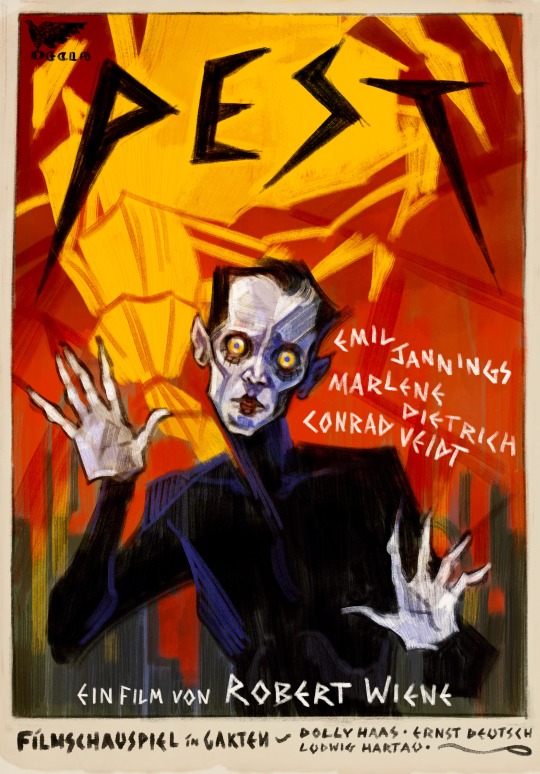
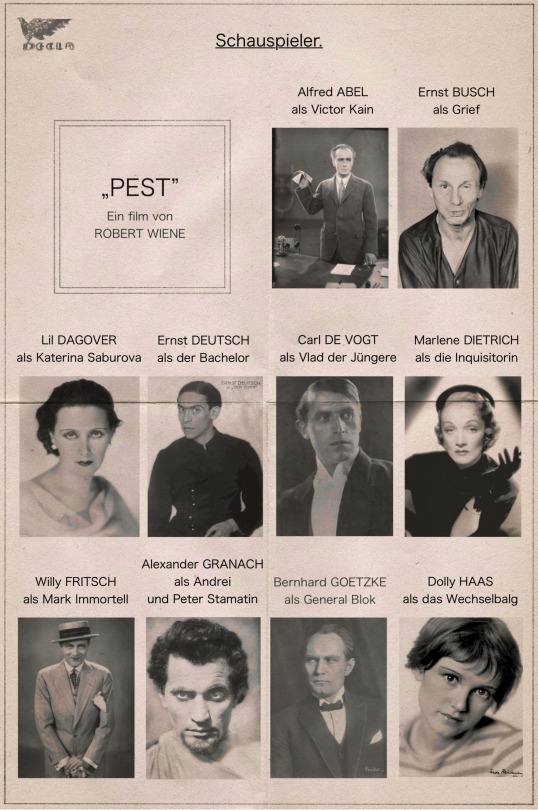

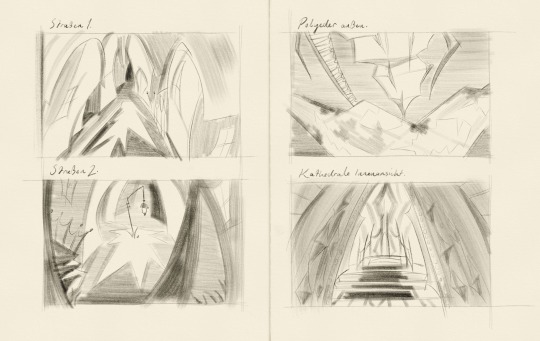

pathologic but it's a lost 1920s german expressionist film [id under cut]
[id:
image 1: a digital drawing of a fake poster, using bright colours and rough, painterly brushstrokes. the title, 'pest' (german for 'plague'), is written at the top in spiky black text. in the foreground a man dressed as a tragedian is staring intently at the viewer, his hands raised and splayed as if in horror. in the background, the town is framed against a red sky, with the polyhedron in yellow behind.
images 2 and 3: fake casting sheets for the film, with the names of the actors and the characters they are playing above a black-and-white portrait photograph of them. all the text is in german. in english it reads:
'Pest', a film by Robert Wiene
Alfred Abel as Victor Kain
Ernst Busch as Grief
Lil Dagover as Katerina Saburova
Ernst Deutsch as the Bachelor
Carl de Vogt as Vlad the Younger
Marlene Dietrich as the Inquisitor
Willy Fritsch as Mark Immortell
Alexander Granach as Andrey and Peter Stamatin
Bernhard Goetzke as General Block
Dolly Haas as the Changeling
Ludwig Hartau as the Haruspex
Brigitte Helm as Anna Angel
Brigitte Horney as Maria Kaina
Emil Jannings as Big Vlad
Gerda Maurus as Yulia Lyuricheva
Lothar Menhert as Georgiy Kain
Asta Nielsen as Lara Ravel
Ossi Oswalda as Eva Yan
Fritz Rasp as Stanislas Rubin
Conrad Veidt as Alexander Saburov and Tragedian
Paul Wegener as Oyun
Gertrud Welcker as Aspity
image 4: four digital sketches of set designs for various locations. all are strongly influenced by expressionist imagery, using extreme angles, warped perspective, and dramatic shapes. they are labelled 'street 1' (a street lined with houses), 'street 2' (a square with a lamppost and a set of steps), 'polyhedron exterior' (the polyhedron walkway), and 'cathedral interior' (the dais at the far end of the cathedral).
image 5: four digital drawings in a black-and-white watercolour style, showing fake stills from the film. all are similarly distorted and lit by dramatic lighting. the first shows katerina's bedroom, with katerina standing in the centre of the floor. the second shows the interior of an infected house. the third shows daniil staring out of the frame in horror, one hand on his head and the other raised as if to ward something off. the fourth shows an intertitle with jagged white text reading 'the first day' against a dark background.
end id.]
#pathologic#artwork#conrad veidt#(i know there are many other actors but i dont have tags for them my bad)#anyway :D this has been my brain project for the past week or so i have been thinking about it so much#i have so many more things i want to draw for it but i am trying to hold myself back. for the sake of my Wrists#also obviously the cast list is way whiter than it should be for pathologic but german expressionist cinema was not particularly diverse an#i was trying to go for realism so apologies for that#i had so much fun with these i dont normally draw locations because i prefer drawing people but i found it so much more enjoyable#when i could mess around with the perspective and make stuff look wacky. thank you expressionism i love you expressionism#also it goes without saying that i was most heavily inspired by the cabinet of dr caligari (which is why i went with robert wiene. he would#do such a great job i think)#i hope you are all well my friends :D kiss you
512 notes
·
View notes
Text


My favorite lil thing is just them being very tropical- doesn’t even need to be out of their lil town it can just be with Home making smoothies n vibin 🌴 (they make sure to share with Home so he doesn’t feel left out)


Also some extra doodles that I basically abandoned, but might as well show
#You already KNOW which song I was listening to for soft beverage seller howdy LMAOOOO#Welcome home#welcome home wally#welcome home howdy#Wally darling#Howdy pillar#wallypillar#Howdydarling#I just want the workaholic and mellow apple enjoyer to have a vacation
2K notes
·
View notes
Text
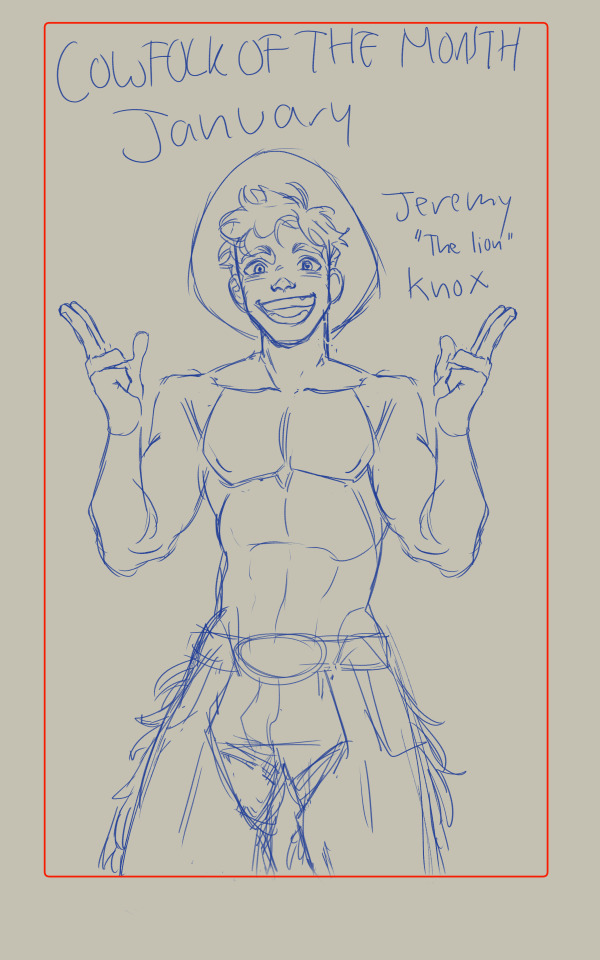
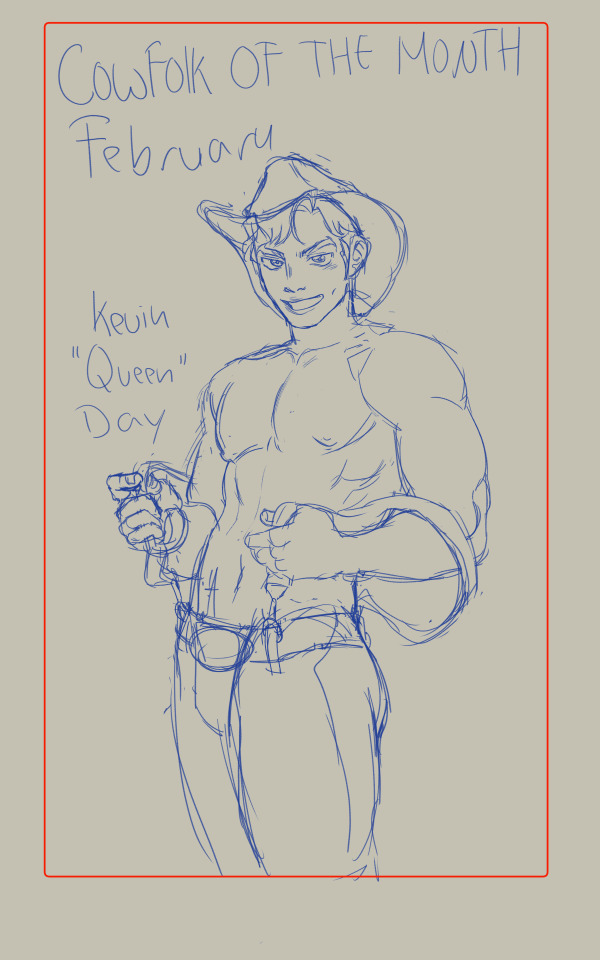

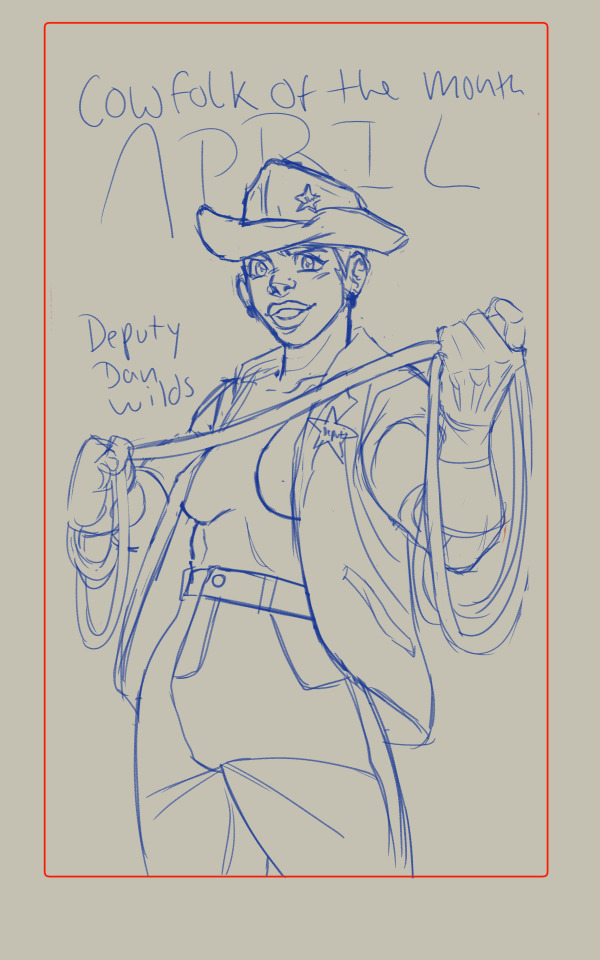

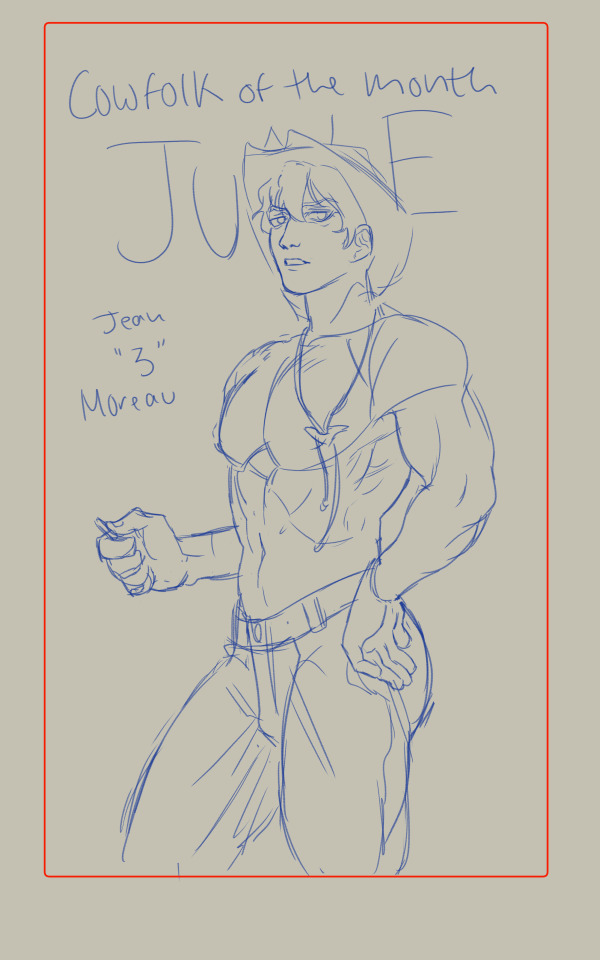
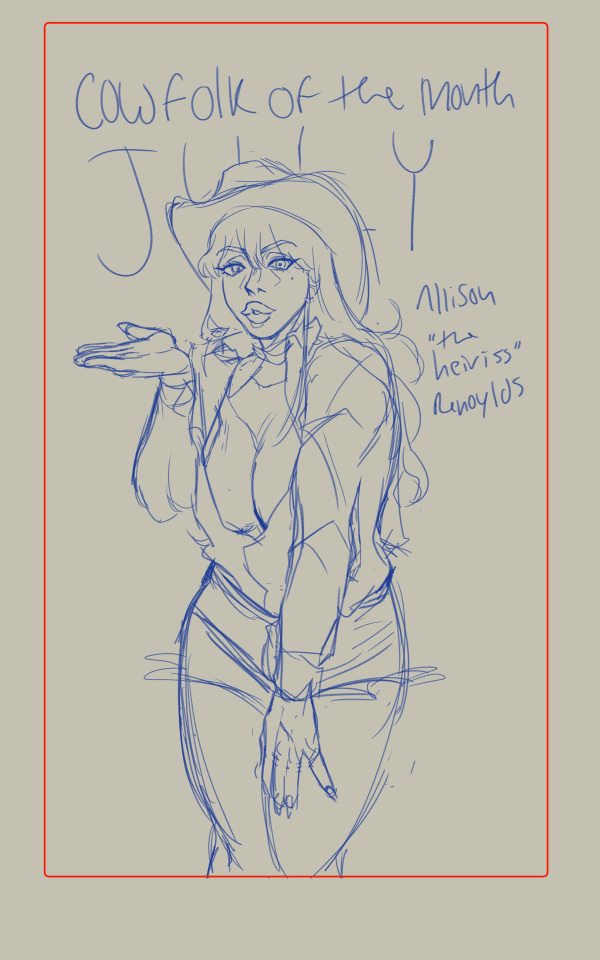

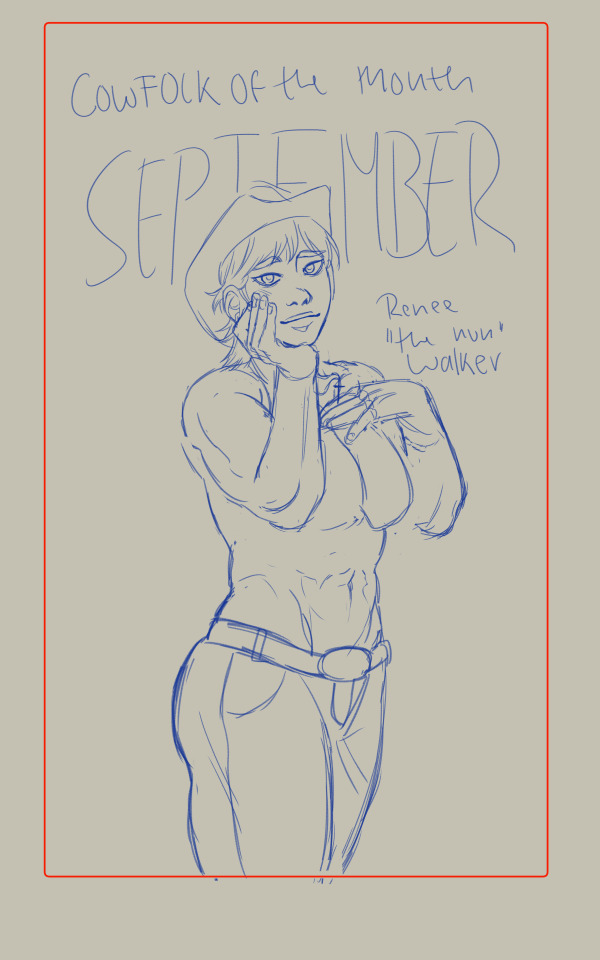
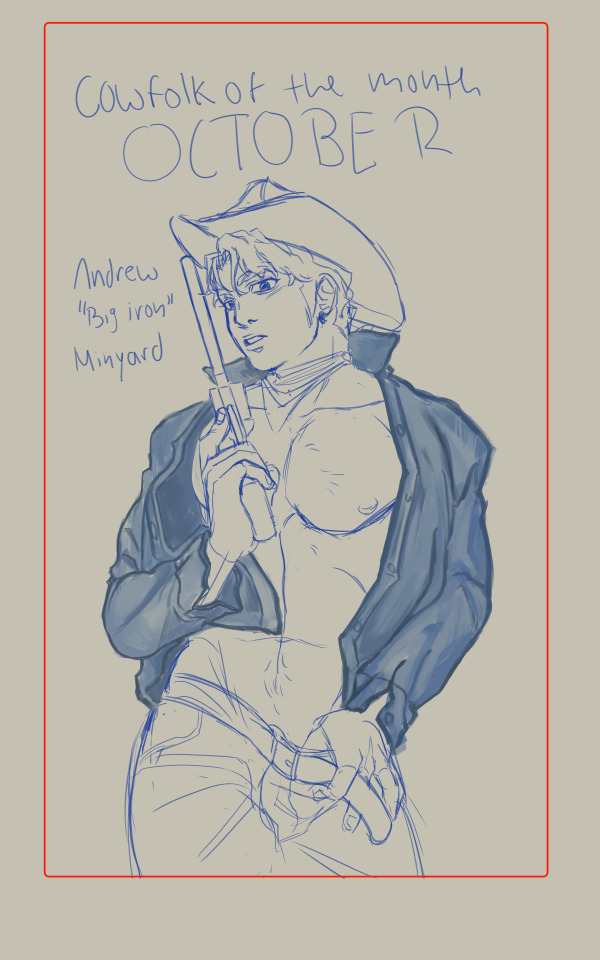
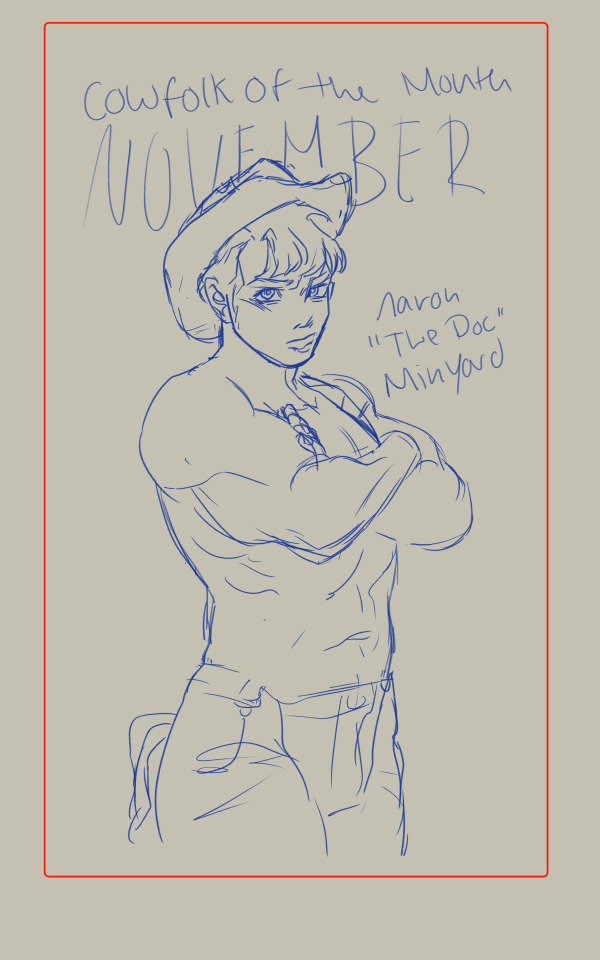

A card set I was planning but will sadly probably never finish. Plus there are only so many sexy cowboy outfits
#all for the game#jeremy knox#kevin day#neil josten#dan wilds#nicky hemmick#jean moreau#allison reynolds#matt boyd#renee walker#andrew minyard#aaron minyard#riko moriyama#sorry seth enjoyers#matt is just fully naked because every hot cowboy fit is just them being shirtless#which gets boring#Renee had a crop top at one point but it vanished
544 notes
·
View notes
Text
lisa frankenstein is the most "target audience" movie ever. it's me i'm the target audience
#lisa frankenstein#i went 2 c it mostly cuz 2day was my last exam and i wanted 2 treat mysef#nd the ticket guy was like haha now theres four of u and like. this movie is gonna b a commercial failure nd hav 30% on rotten tomatoes#it isnt even like i think this movie is the best movie wver it was just made like specifically for queer chronically online gen z which#makes it very enjoyable 2 me#maybe i have never fully understood the meaning of target audience cuz i never watched movies geared specifically 2 me#upl
541 notes
·
View notes
Text
when you find out mercers emptied the guild safe and stolen everything brynjolf says “by the eight” but later if you talk to him in irkngthand he says “by talos, mercer has a lot to answer for” which is probably just an inconsistency but also i feel like it could imply he’s excluding one of the other divines from the eight
#we stan an inconsistent king#maybe he’s a closet talos enjoyer but then again riften is stormcloak territory#anyways which of the other divines do you think he’s got beef with /j#skyrim brynjolf#brynjolf#skyrim#tes skyrim#tesblr
2K notes
·
View notes
Text

Hoist the beast 👏👏👏
#rain world#rw spearmaster#seven red suns#assembly#my art#been working on this one in bed for quite a few days now#many details#it was fun#also playing with new spearmaster design#which was enjoyable also#i like this one ngl#might do a version with the other arm having drapey bits at some point but idk#for now they are asymmetric
467 notes
·
View notes
Text

A little animation I've been working on to put on my livestreams
#animation#original art#original character#there are still things that bother me but I've been tweaking this for weeks IT NEEDS TO BE FINISHED#I did cleanup and color on this in photoshop which was actually more enjoyable than I expected
495 notes
·
View notes
Text


Attorney Iris commission for an AU written by a lovely author named Armando on fanfic.net! Their fic is linked!
#doctorsiren#ace attorney#ace attorney au#iris hawthorne#iris fey#ace attorney fanart#not my au#art#digital art#my art#fanart#procreate#commission#art commission#this is actually the second time I’ve been comm’d to draw Iris! which is really neat bc I love her#their AU is interesting because I am an Iris enjoyer hehe
428 notes
·
View notes
Text

⦿ Help Zygarde end the clash between Xerneas and Yveltal and restore order.
#pokemon fanart#pokemon xy#pokemon legends#zygarde#xerneas#yveltal#pokemon legends z-a#pokemon legends ZA#pokemon legends za#kalos#pokemon x and y#pokemon#sorry guys cannot help but keep drawing scenarios#they're so fun to play around with#although that often raises high expectations (which I blame myself for that)#2 big reasons why I enjoyed indigo disk = drawing art and engaging in theories within the community#the hype season really helped make the DLC experience more enjoyable; while I liked ID#I have major gripes with the story (aside from kieran's).#I hope xerneas & yveltal gets more role! Really solid designs and lore-stuffed creatures yet unfortunately underutilized like Terapagos
243 notes
·
View notes
Text
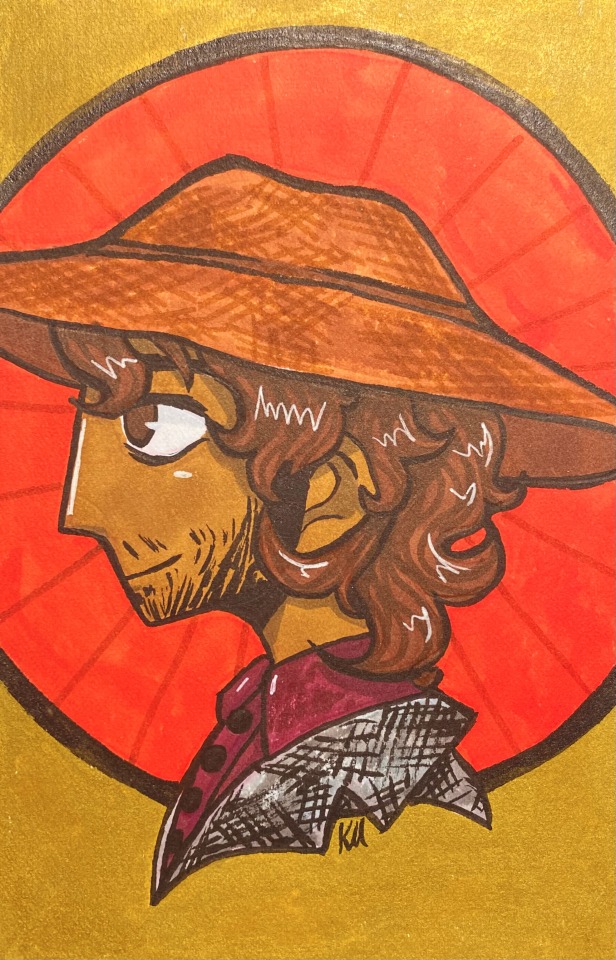
Yeehaw it’s my favourite western character Texas man from British vampire gothic horror by famous Irish guy
#I made this awhile back and was waiting for a big Quincey day to post this but fuck it I love how this turned out#quincey morris#quincey p morris#dracula#dracula daily#re dracula#re: dracula#Art#traditional art#artwork#illustration#markers#alcohol markers#lol I’m actually a huge western enjoyer (but no one else around me is so I basically have no interaction with the genre :( )#I used to find the southwest as a setting boring but then my family dragged me out to Utah and Arizona and something just clicked#Like. Oh. These are beautiful vast areas with a stunning geography and a vibrant history and culture#And out west 110 Fahrenheit feels like 80 Fahrenheit which was crazy to me (I made sure to wear a lot of sun protection)#I also realized I was gay and that played into it
181 notes
·
View notes
Text
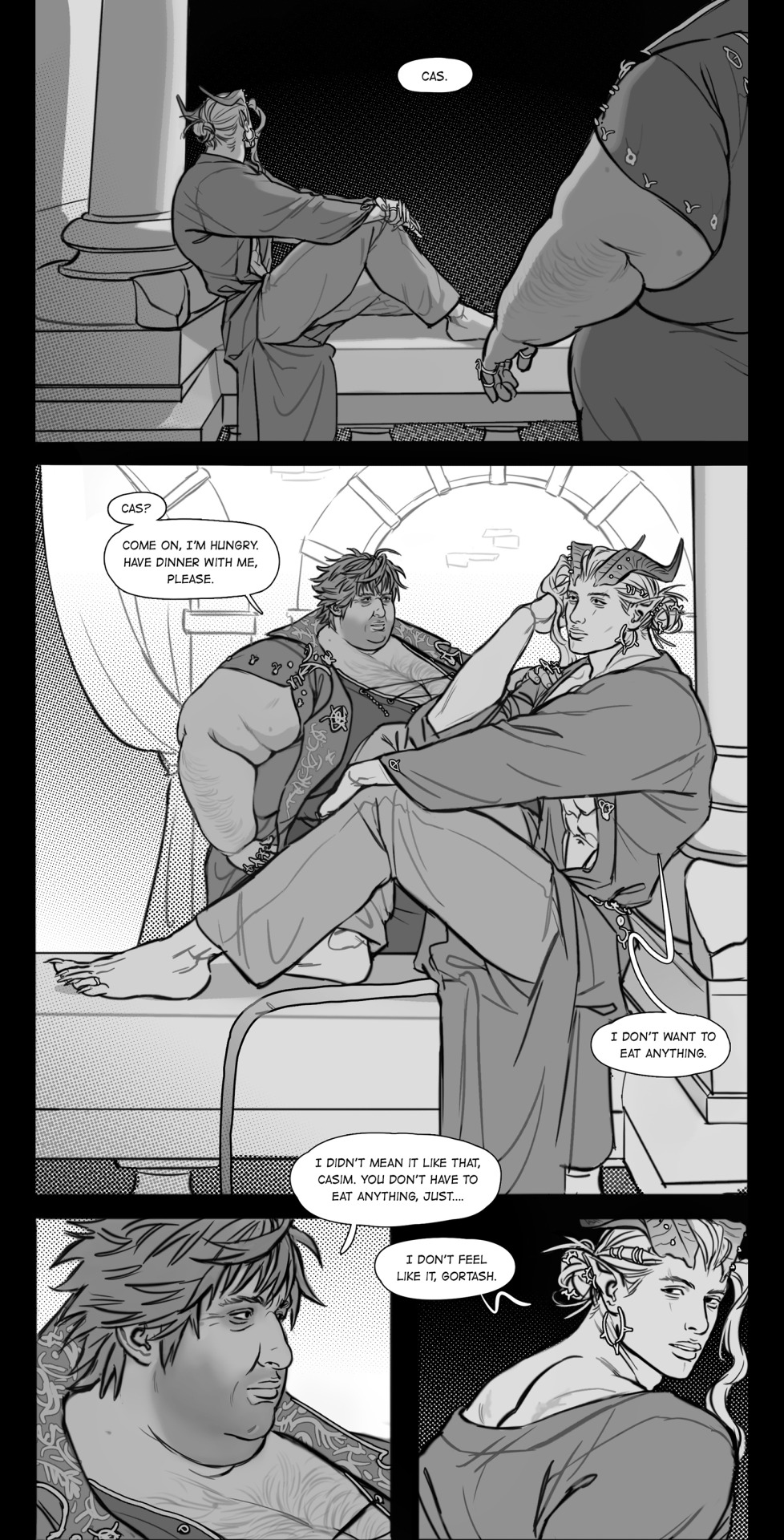
#art tag#gortcas#casim carnarvon#sorry guys proper context some other time maybe idk how to do it right now so no caption it is🤕#the tldr is that Gortash offhandedly talked about how Cas can make him as fat as he pleases but really it wont make him him his#basically that he only allows Cas to have his way but hes still in full control#which is true yes and Cas knows that to an extent but its not something he wants to hear#because Cas very much holds onto the hope that Gortash will be his forever at some point. phsyically#because again. Cas won't ever believe just words he simply is unable to even if Gortash could never love anyone else#at the same time while yes he obviously enjoys the whole weight gain he does not consider his own enjoyment a good reason to do things#Cas is someone that very much disregards his own enjoyment of things as well as his wellbeing#Cas is just pulling away instead of acting mad in an obvious way. hes sticking around but hes not feeding or teasing him about his weight#and Gortash? is now left with not knowing how to fix it since Cas isnt acting as he usually does when hes hurt or mad. hes still there#and day after day passes where he yearns to have it back. practically begging Cas to continue so he can prove his devotion#prove that he mustve been wrong with his comment. that Cas can push his body as far as he wants to and he'll be his in the end#thx for reading my tags guys maybe i can share more about this scene some other time🙂↕️ for now just have the art
310 notes
·
View notes